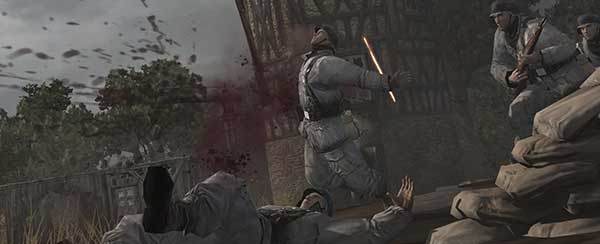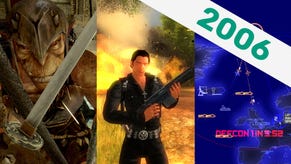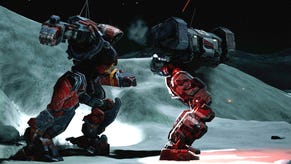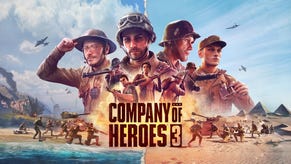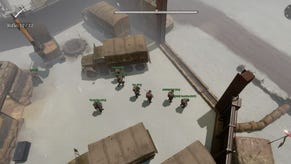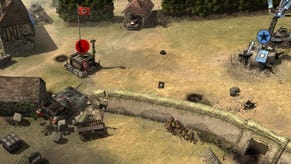Wot I Think - Company of Heroes: Tales of Valor
The second expandalone (YES I SAID THE DEVIL-WORD) for Relic's sumptuous World War II RTS hit our excited PCs late last week. I duly celebrated Easter by killing a lot of men in it. Is it the meaty expansion we've been praying for, or money-grabbing tokenism? My hammer of ultra-judgement falls on it below...
When a game’s called ‘Tales of Valor’ and over two-thirds of its running time has you playing as Nazis Germans, it’s hard not to wonder if there was some sort of breakdown in internal communications. We’re by now fairly accustomed to and comfortable with occasionally stepping into Axis jackboots in World War II games, but to have an entire game place them largely centre-stage and thus the de facto heroes of the piece is a really odd decision, to say the least.
Quite obviously, it’s not that Relic are all secretly Axis fanboys, or that they think their players are. Perhaps its genuine boldness, or a decision that these were the most interesting tales to tell, but frankly I’d imagine it’s more just one symptom that Company of Heroes perhaps isn’t being as finely-managed as it once was, now Dawn of War II’s the new baby. Similarly, this standalone expansion (though it does plug into existing COH installs if you have ‘em) is a strange hybrid of inventiveness and incoherence.
As a result (or perhaps a cause), it’s remarkably hard to identify quite why Tales of Valor exists. I’ve personally settled, poisonous little cynic that I am, on there being a dictat from above that more COH would make money, so someone threw something together. It’s not a failure, not at all – it’s simply a little pointless.
The main conceit is the titular stories of heroism – three short singleplayer campaigns, of around 90 minutes each, presenting some of World War II’s most theoretically thrilling scuffles within a heavily-scripted, heavily-cutscened series of linked levels. Lately, Relic have been experimenting heavily with ways to reinvent singleplayer strategy, as it’s something that often struggles to make the same impact as the multiplayer component. Dawn of War II’s campaign borrowed heavily from Diablo, Soulstorm tried the Total War thing, and now this is about the most tightly-scripted RTS ever made. No glorified skirmish maps here – every enemy, and every enemy movement, is pretty much pre-determined.
In fact, it’s closer to the excellent Men of War than Company of Heroes – base-building is excised in most of the maps, and there’s a gentle focus on acquiring weapons and ammunition (for special powers rather than units’ guns) from what’s already on the map. While it's a more fulfilling approach than the original COH's singleplayer, these two styles of strategy don't quite mix seamlessly here, and it’s yet another affirmation that MoW is a far better singleplayer game than CoH has ever been. The blend of organic, what-you-see-is-what-you-can-use with abstract, icon and resource-based special abilities is uncomfortable. Imagine a first person shooter where grenades were an intangible, invisible essence that gradually replenished over time, rather than something your character had x number of.
While it’s very different to Dawn of War II’s weirdy-beardy semi-RPG singleplayer, there is a similar sense of disjointedness, of a collection of strong ideas that don’t mesh together as smoothly as they could. And honestly, when 3 hours of your 4.5 hour game are spent playing as the Nazis Germans, you’re either astonishingly confident or perhaps not entirely clear what the audience wants from a WW2 game.
None of this is to say it’s not enjoyable. There’s a likeable, natural flow to it, in most cases each new sub-level of the three tales being a reaction to some misfortune that has befallen your small army. The opening Tiger tank campaign begins with your being all-conquering in your steel goliath, then moves onto a desperate escape when the tank’s trashed and its surviving crew need to flee for safety from a rampaging Allied force. There’s no investment in the characters – all blandly stiff-upper-lipped spouters of exposition or military derring-do – but there is in the situation. You remain on the same map throughout a campaign, its shape and content evolving as the war over it progresses. Unlocks carry over between sub-levels, so throughout those 90 minutes you’ll escalate from having a handful of guys with popguns to levelling the land with artillery strikes called in from off-screen. It’s more satisfying than the hard-stop, reset the tech tree come the next level approach of traditional RTS singleplayer.
That said, there really isn’t a lot of variety in how you best the challenges, so replay value is essentially nil, bar possibly tackling the campaigns again at a higher difficulty. Again, this is a curiously purposeless expansion, ultimately coming across almost like an appetiser for COH’s main course rather than the filling desert it should be. It should be profiteroles – instead, it’s Nazi-themed garlic bread.
Perhaps that’s the point – it’s an easy-in to lure new players into picking up COH and Opposing Fronts, rather than aimed at veterans. The didacticism and relative ease of the campaigns would, at a guess, very much appeal to an older gamer who wants a neatly encapsulated World War II battle rather than the complexity and micro-management of COH vanilla. That title is key – this is not war, but war stories.
So, really, it doesn’t expand upon the Company of Heroes experience enough to be an advisable sale to long-term players. You’ll have a better time playing team versus with some chums, creating a unique and far more epic narrative rather than simply experiencing the arbitrary defeats and victories Tales of Valor has pre-determined you’ll experience. If you want a glorious, involving and hellaciously explosive singleplayer World War II experience, Men of War is absolutely where to go.
There is, though, one thing that makes this a little more noteworthy to CoH old hands. Amongst some token new multiplayer units and maps is the Stonewall mode (there are also new hero-centric and tank-centric modes, neither of which are quite as elegant) – defending a fixed, pre-built base against escalating waves of invading Nazis Germans. Every building lost brings you not so much closer to defeat, but rather loses you access to specific units and upgrades. You can survive the loss of a few, but each one that crumbles is a harrowing punch the gut.
It can be played solo, but it’s best tackled as a co-op game – an Alamo moment, stood shoulder-to-shoulder against impossible odds. It’s as thrilling gruelling as Company of Heroes gets, but it alone is not enough to justify the asking price if you’re not fussed about the campaign gubbins. It’d be ideal, and celebrated with tears of joy, as patch content – but that’s unlikely, outside of third-party mods.
It’s unlikely that this is Company of Heroes’ last gasp, given how long Relic strung out Dawn of War 1 for, and the menu system is now positively setup for plugging in new micro-campaigns as and when. If buying Tales of Valor wins you access to new ones for free, it’s an investment worth making – 90 minutes of 1940s explodey fun every now and again.
Perhaps best, then, to wait and see what happens, and what Relic’s plans for COH are. It still looks amazing, it still plays with satisfying polish and freshness, and there’s still a crapton of WW2 it hasn’t documented, so there’s scarecely a need for a sequel just yet. Let’s hoping this good-natured mild misfire is just Relic treading water while they decide exactly what COH’s next move proper is.
Tales of Valor is available over Impulse or Steam now. For far too much money, quite frankly - fortunately it's much cheaper from etailers such as Amazon and Play.



